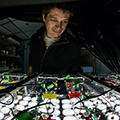Visit the exhibition
Discover the incredible stories of life on our planet through powerful photography and expert insight.
Tickets on sale now.

By day this colony of army ants raided their surrounds, mostly hunting other ant species. At dusk they moved on, travelling up to 400 metres before building a nest for the night. Positioning his camera on the forest floor, Daniel was wary of upsetting thousands of venomous army ants. ‘You mustn’t breathe in their direction,’ he says.
Army ants alternate between nomadic and stationary phases. These ants are in a nomadic phase, building a new nest each night using their own bodies. The soldier ants interlock their claws to form a scaffold while the queen stays inside in a network of chambers and tunnels. During the stationary phase they will stay in the same nest while the queen lays new eggs.
Discover the incredible stories of life on our planet through powerful photography and expert insight.
Tickets on sale now.

Germany/USA
Daniel heads the Laboratory of Social Evolution and Behavior at the Rockefeller University in New York City. While much of his research is lab-based, he also conducts fieldwork on army ants. In 2017, a newly discovered beetle (Nymphister kronaueri), which lives inside army ant colonies as a social parasite and rides on the ants during colony emigrations, was named in his honour.
Help us harness the power of photography to advance scientific knowledge, spread awareness of important issues and nurture a global love for nature.